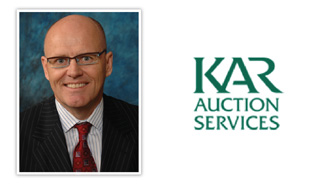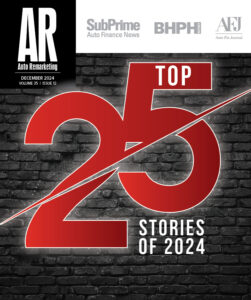Hallett Praises KAR Management for 2010 Success

KAR Auction Services chief executive officer Jim Hallett challenged his management team in 2010 with a long list of objectives.
In sharing how the company grew its income and revenue year-over-year, Hallett mentioned one of these goals and immediately followed by saying, “and we did."
“As I reflect on 2010, I’m very proud of the management team,” Hallett stated Thursday during a conference call with investment analysts as KAR detailed its fourth quarter and full-year financial performance.
“I think at the end of the day we get judged on doing what we say we’re going to do. I think the management team did a great job,” he continued.
In listing items like a “report card,” Hallett said the company expanded its revenue per vehicle in 2010. He also pointed out KAR sought to make selective acquisitions last year, highlighting that the company spent almost $50 million in the fourth quarter alone.
“I believe this will continue to strengthen our brands at ADESA and Insurance Auto Auctions,” Hallett interjected.
The CEO moved on to a pledge to repay debt, noting KAR paid down $150 million in the fourth quarter and almost $400 million in 2010.
Hallett insisted one of KAR’s key goals for the year was to ramp up dealer business. He reported that this activity was up 14 percent in the fourth quarter on a same-store basis and climbed 7 percent on a same-store basis year-over-year.
The company also sought to leverage its technological capabilities. Hallett noted online volumes moved higher throughout 2010 as ADESA posted 22 percent of its sales through the Internet. The penetration was even higher for Insurance Auto Auctions and the company’s top executive said 50 percent of this division’s transactions happened online.
Continuing on, Hallett told analysts that KAR is reaching out for international opportunities, too.
“As most of you know, this is a longer-term initiative and I certainly have nothing significant to report at this time except I would say we’ve established very good relationships around the world and the ADESA brand is very well recognized and well respected,” he shared. “I believe we’re well positioned should an international opportunity be identified.”
After rattling off those achievements, Hallett declared, “They really position us to do well in the future.”
KAR’s 4Q Overall Performance
Looking first at KAR’s fourth-quarter performance, the company generated $441.3 million in revenue, a 6-percent rise from the year-ago total, which was $417.9 million.
The revenue allowed KAR to post a 3-percent year-over-year gain in fourth-quarter adjusted EBITDA, climbing to $103.0 million from $99.7 million.
And the company’s net income also made a year-over-year positive advance. Executives determined their fourth-quarter net income moved up to $7.3 million or 5 cents per diluted share as compared with net income of $5.3 million or 5 cents per diluted share in the year-ago period.
KAR pointed out its adjusted net income per share for the fourth quarter was 20 cents versus adjusted net income per share of 15 cents for the fourth quarter of 2009
KAR’S Full-Year Overall Performance
Executives continued their broad financial rundown by sharing how KAR did throughout 2010.
The company’s revenue climbed 5 percent year-over-year as KAR generated $1.815 billion last year as compared with $1.729 billion in 2009.
Meanwhile, executives highlighted that their 2010 adjusted EBITDA shot up 12 percent from the 2009 figure, increasing from $425.9 million to $475.2 million.
When looking at net income, KAR’s positive strides also stood out. The company moved from a 2009 net income level of $23.2 million or 21 cents per diluted share to a 2010 reading of $69.6 million or 51 cents per diluted share.
Closer Look at ADESA Performance
The 2010 wholesale market played a major role in ADESA’s year-end financial statement.
The company calculated ADESA’s 2010 revenue slid down 1 percent from the previous year, settling at $1.075 billion as compared with $1.088 billion in 2009.
Consequently, ADESA’s annual gross profit ticked down a bit, too. The 2-percent decline or $8.4 million left the 2010 figure at $464.7 million compared with $473.1 million at the end the prior year.
ADESA indicated its gross margin edged slightly lower year-over-year, moving down from 43.5 percent in 2009 to 43.2 percent.
Executives explained the decrease in revenue and gross profit were primarily a result of a 7-percent decrease in the number of vehicles sold that was partially offset by a 6-percent increase in revenue per vehicle sold.
Due primarily to an increase in non-cash stock compensation expense, ADESA determined its selling, general and administrative expense increased $4.8 million to $211.9 million.
For the year ADESA discovered that its used-vehicle conversion percentage declined to 65 percent as compared with 66.9 percent for 2009.
“The decline in conversion rate, which contributed to the decline in gross margin, was driven in part by the company’s growth in dealer consignment vehicles, which typically convert at a lower conversion rate than institutional vehicles,” KAR executives emphasized.
Update on IAA Performance
Where ADESA might have lost traction in 2010, KAR executives said the situation turned into a gain for Insurance Auto Auctions.
The company determined IAA’s 2010 revenue jumped 10 percent or $57.3 million to $610.4 million. In 2009, the division generated $553.1 million in revenue.
Insurance Auto Auctions’ gross profit spiked, too, as it went up by 24 percent to $248.4 million. That figure is $47.4 million higher than the 2009 total, which was $201.0 million.
Executives revealed 2010 gross margin for IAA was 40.7 percent, up from the 2009 level that settled at 36.3 percent.
“The increases in revenue and gross profit for the year were primarily a result of an increase in average selling price for vehicles sold at auction, partially offset by a decline of less than 2 percent in salvage vehicles sold,” KAR pointed out.
The company also mentioned Insurance Auto Auctions’ increase in selling, general and administrative expense to $78.9 million was primarily due to increases in incentive and non-cash stock compensation expense as well as increased professional fees related to the division’s process improvement initiatives.
How Did AFC Fare in 2010?
Another segment that boosted KAR’s bottom line was AFC’s performance.
Executives computed that AFC’s revenue soared 46 percent last year, coming in at $128.7 million from $88.0 million in 2009.
The percentage spike for AFC’s gross profit was even higher — 72 percent. Executives highlighted the year-end figure climbed from $58.2 million in 2009 to $100.2 million at the close of last year.
As a result, executives determined gross margin for AFC was 78 percent for 2010 versus 66 percent for the previous year. They explained the increase in revenue and gross profit were primarily a result of a 25-percent increase in revenue per loan transaction and a 17-percent increase in loan transaction units.
AFC also found the increase in revenue per loan transaction was primarily a result of an increase in average loan value and a $6.1 million decrease in bad debt expense to $11.2 million.
Furthermore due primarily to increases in incentive and non-cash stock based compensation expense, payroll costs and professional fees, AFC determined selling, general and administrative expense increased $7.0 million to $18.6 million.
KAR’s Liquidity and Capital Resources
KAR indicated it has a $250 million revolving line of credit as part of the company’s $1.865 billion credit agreement, which was undrawn as of Dec. 31. The company said there were related outstanding letters of credit totaling approximately $29.4 million and $31.7 million at the end of 2010 and 2009, respectively, which reduced the amount available under the senior credit facility.
As Hallett mentioned earlier, KAR used $420.7 million in cash during 2010 to repay long-term debt, including payments for the early extinguishment of debt and related prepayment penalties, $78.9 million to purchase property, plant and equipment and $50.7 million to acquire businesses, including contingent payments for previous acquisitions.
In addition, executives revealed the inclusion of the obligations collateralized by finance receivables and related finance receivables on the balance sheet in 2010 resulted in an increase in cash from operations of $148.9 million. They stressed the changes in these amounts are now included in investing and financing activities in their statement of cash flows.
“The company believes that the significant indicators of liquidity for its business are cash on hand, cash flow from operations, working capital and amounts available under its credit facility,” KAR executive team stated.
“The company’s principal sources of liquidity consist of cash generated by operations and borrowings under its revolving credit facility,” KAR added.
Reaction to Remarketing Industry Shifts
Before speculating about how KAR might perform financially this year, Hallett was asked again about outlets such as rental car companies bypassing auctions to remarket their vehicles.
“As I’ve said in past calls, the rental companies continue to look for alternative channels. Specifically, I think we’re all aware that Hertz has been more aggressive in this area with stated goals of wanting to reduce their reliance on auctions and go to alternate channels,” Hallett stated.
Last month, Hertz Global Holdings rolled out Hertz Dealer Direct, an online remarketing program that allows dealers to directly acquire high-quality rental units from the company. Hertz Dealer Direct is designed to offer these late-model units to dealers at “competitive prices” and doesn’t require a transaction fee. Here is how the process works. Dealers and wholesale buyers can sort through the vehicles Dealer Direct has in its inventory, whether the models are currently on-rent units that are ready for sale or grounded units that can be purchased and picked up immediately.
Hertz also has been touting its Rent2Buy Program, a consumer initiative. As some may know, Hertz Rent2Buy works like this. A shopper can reserve a vehicle online, pick it up at a nearby Hertz location and test-drive it for three days. After the three-day period, consumers can choose to either buy the vehicle at the listed price or return the vehicle. If they choose the latter option, it’s simply considered a standard rental transaction.
No matter what Hertz might be doing, Hallett emphasized, “From our standpoint, our relationships are very good with the other rental companies. Our rental business continues to grow and should grow in 2011 as a percentage of our business.
“Although the rental companies will look for alternate channels, the one thing for sure is the auction channel does give you immediate liquidity and sometimes as you know time is worth money,” he added.
More Commentary about 2011 Outlook
Beyond the brief mention of rental-car business as well as the ongoing program to boost dealer consignment, KAR shared some specific projections for how its 2011 balance sheet might look.
The company expects 2011 adjusted EBITDA of approximately $500 million, net income per share of 75 cents to 80 cents and adjusted net income per share of $1.20 to $1.25.
In addition this year, the company thinks its effective tax rate will be approximately 30 percent and its capital expenditures to be approximately $80 million.
“While many people look at our businesses individually, I believe the real value in KAR is the complementary nature of these businesses as we combine them,” Hallett insisted. “That’s the message we’ve been trying to preach here for the last year or so.”

 View The Latest Edition
View The Latest Edition

